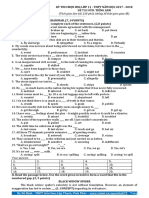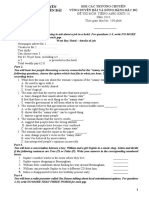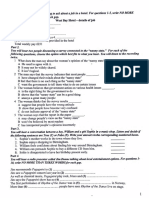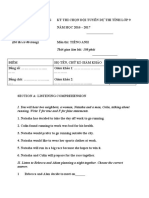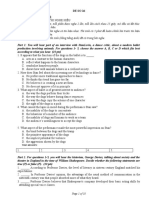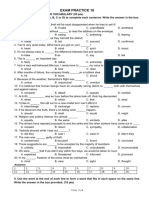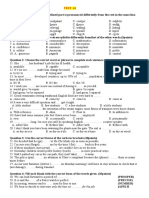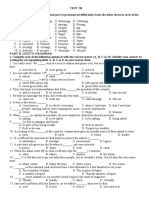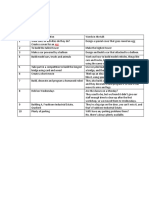0 ratings0% found this document useful (0 votes)
40 viewsTest 34
Test 34
Uploaded by
HaCopyright:
© All Rights Reserved
Available Formats
Download as DOC, PDF, TXT or read online from Scribd
Test 34
Test 34
Uploaded by
Ha0 ratings0% found this document useful (0 votes)
40 views11 pagesOriginal Title
TEST 34
Copyright
© © All Rights Reserved
Available Formats
DOC, PDF, TXT or read online from Scribd
Share this document
Did you find this document useful?
Is this content inappropriate?
Copyright:
© All Rights Reserved
Available Formats
Download as DOC, PDF, TXT or read online from Scribd
Download as doc, pdf, or txt
0 ratings0% found this document useful (0 votes)
40 views11 pagesTest 34
Test 34
Uploaded by
HaCopyright:
© All Rights Reserved
Available Formats
Download as DOC, PDF, TXT or read online from Scribd
Download as doc, pdf, or txt
You are on page 1of 11
TEST 34
PART I: VOCABULARY AND GRAMMAR. (7, 0 POINTS)
I. Choose the best option to complete each of the sentences. (2,0 points)
1. The strike was ___ owing to a last minute agreement with the management.
A. called off B. broken up C. set back D. put down
2. Lindsay’s excuses for being late are beginning to ___ rather thin.
A. get B. turn C. wear D. go
3. ___ the people who come to this club are in their twenties and thirties.
A. By and large B. Altogether C. To a degree D. Virtually
4. My cousin was nervous about being interviewed on television, but she rose to the ___ wonderfully.
A. event B. performance C. incident D. occasion
5. The train service has been a ___ since they introduced the new schedules.
A. shambles B. rumpus C. chaos D. fracas
6. Is an inexperienced civil servant ___ to the task of running the company.
A. capable B. skilled C. eligible D. suited
7. We ___ have been happier in those days.
A. can’t B. couldn’t C. might not D. must not
8. You’ve lived in the city for most of your life, so ___ you’re used to the noise.
A. apparently B. presumably C. allegedly D. predictably
9. The storm ripped our tent to ___
A. slices B. shreds C. strips D. specks
10. He ____ so much harm on the nation during his regime that it has never fully recovered.
A. indicted B. inferred C. induced D. inflicted
11. Hotel rooms must be ____ by 10 a. m, but luggage may be left with porters.
A. vacated B. evacuated C. abandoned D. left
12. I do not think there is so much as a ____ of truth in that rumor.
A. crumb B. speck C. grain D. pebble
13. He’s not exactly rich but he certainly earns enough money to ____
A. get through B. get by C. get on D. get up
14. I have very ____ feelings about the plan – it might possibly work or it could be a disaster.
A. certain B. mixed C. doubtful D. troubled
15. The noise of the typewriter really ____ me off. I just couldn’t concentrate.
A. put B. pulled C. set D. took
16. The sixth time he called me at night was the ____
A. last cause B. last straw C. touch and go D. hot air
17. All three TV channels provide extensive ____ of sporting events.
A. broadcast B. network C. coverage D. vision
18. They seemed to be ____ to the criticism and just carried on as before.
A. disinterested B. sensitive C. uncaring D. indifferent
19. “Shall we go out tonight?” - “____”
A. Yes, I can B. Yes, we are C. Yes, we go D. Yes, let’s
20. It's no use ___ over ___ milk.
A. crying/ spilt B. to cry/ spilling C. crying/ spilling D. crying/ to spill
Your answers:
1. 2. 3. 4. 5.
6. 7. 8. 9. 10.
11. 12. 13. 14. 15.
16. 17. 18. 19. 20.
II. Read the passage below. Use the word given in bold to form a word that fits in the numbered gap.
(2, 5 points)
BLACK WIDOW SPIDER
The black widow spider’s notoriety is not without foundation. However, an element of exaggeration
has led to certain ___ (1. CONCEPT) regarding its evil nature.
Firstly, this spider is not as dangerous as is often thought. While it is indeed one of the most ___ (2.
VENOM) species of spider, its venom being fifteen times stronger than that of the prairie rattlesnake, its bite
injects such as amount of venom by ___ (3. COMPARE) that it is unlikely to kill humans. In fact, ___ (4.
FATAL) are rare.
Black widows bite only if they are touched or their web is threatened. Furthermore, only the adult
female is poisonous. Those most at risk from the female are the spider’s natural pray-insects-and male black
widow spiders. The latter are vulnerable as the female is ___ (5. SOLITUDE) by nature, and has been known
to kill and eat the male after mating. Such ___ (6. OCCUR) are rare, but they explain how the spider got its
name – and its reputation.
Nevertheless, the ___ (7. PLEASE) effects of this spider’s bite should not be ___ (8. ESTIMATE),
and if you live in a temperate climate and have a fireplace in your home, it is advisable to take ___ (9.
CAUTION). Black widow spiders often inhabit wood piles, so you should wear gloves when handling
firewood. Furthermore, since black widow spiders are ___ (10. RESIST) to many insecticides, you should
regularly clean out likely hiding places.
Your answers:
1. 2. 3. 4. 5.
6. 7. 8. 9. 10.
III. Complete each sentence with the correct form of ONE of the two-word verbs. (2, 0 point)
bring out do up slow down save up hang over
mix up grow up go with dress up run for
1. Silence ___the theatre as the audience awaited the opening curtain with expectation and excitement.
2. Having seen a sharp bend ahead, Tim pressed hard on the brake pedal to ___.
3. Charles Dickens was born near Portsmouth, Hampshire on 7 February 1812, but relocated to and ___ in
Camden Town in London.
4. Barrack Obama has decided to ___ the American presidency in the election that will take place next year.
5. Because I hate ___ my shoes, I have bought a pair of shoes without any laces.
6. Sarah wanted to buy some curtains that would ___ his furniture, so she had brought a photo of her sofa
with her to the store.
7. Kate had been ___ in order to buy a new laptop, but then she decided to use the money on the guitar
lessons instead.
8. Even though two of the bands are dead, a new ‘The Beatle’ album called Love was recently ___.
9. Brendan was worried about having to ___ for the boss’ retirement dinner as he didn’t own any formal
clothes.
10. He ___ his grandmother’s phone number with his girlfriend’s, which led to some embarrassment for him.
Your answers:
1. 2. 3. 4. 5.
6. 7. 8. 9. 10.
IV. The passage below contains TEN mistakes. Underline them and write the correct forms in the
numbered boxes. (2, 5 points)
Large animals inhabit the desert have evolved adaptations for reducing the effects of extreme hot. One
adaptation is to be light in color, and to reflect the Sun's rays. Desert mammals also depart from the normal
mammalian practice of maintaining a constantly body temperature. Instead of try to keep down the body
temperature inside the body, what would involve the expenditure of water and energy, desert mammals allow
their temperatures rise to what would normally be fever height, and temperatures as high as 46 degree Celsius
have been measured in Grant's gazelles. The overheated body cools down during the cold desert night, and
indeed the temperature may fall unusual low by dawn, as low as 34 degrees Celsius in the camel. This is a
advantage since the heat of the first few hours of daylight absorb in warming up the body.
Your answers:
1. 2. 3. 4. 5.
6. 7. 8. 9. 10.
PART II: READING COMPREHENSION. (6, 0 POINTS)
I. Read the passage and fill in each of the blanks with ONE suitable word. (2,0 points)
True relaxation is most certainly not a matter of flopping down in front of the television with a
welcome drink. Nor is it about drifting (1) ___ an exhausted sleep. Useful though these responses to tension
and over-tiredness (2) ___ be, we should distinguish between them and conscious relaxation in (3) ___ of
quality and effect. (4) ___ of the level of tiredness, real relaxation is a state of alert yet at the same time
passive awareness, in which our bodies are (5) ___ rest while our minds are awake.
Moreover, it is as natural for a healthy person to be relaxed when moving as resting. (6) ___ relaxed
in action means we bring the appropriate energy to everything we do, so as to have a feeling of healthy
tiredness by the end of the day, (7) ___ than one of exhaustion. Unfortunately, as a result of living in today’s
competitive world, we are under constant strain and have difficulty in coping, (8) ___ alone nurturing our
body’s abilities. What needs to be rediscovered is conscious relaxation. With (9) ___ in mind we must apply
ourselves to understanding stress and the nature of its causes (10) ___ deep-seated.
Your answers:
1. 2. 3. 4. 5.
6. 7. 8. 9. 10.
II. Read the text and do the tasks as follow. (2, 0 points) OUT OF THE ASHES
Paragraph A
On the afternoon of 30th August 1989, fire broke out at Uppark, a large eighteenth century house in
Sussex. For a year builders had been replacing the lead on the roof, and by a stroke of irony, were due to
finish the next day, on August 31st. Within fifteen minutes of the alarm being sounded, the fire brigade had
arrived on the scene, though nothing was to survive of the priceless collection on the first floor apart from an
oil painting of a dog which the firemen swept up as they finally retreated from the blaze. But due to the
courage and swift action of the previous owners, the Meade-Featherstonhaugh family, and the staff, stewards
and visitors to the house, who formed human chains to pass the precious pieces of porcelain, furniture and
paintings out on to the lawn, 95 percent of the contents from the ground floor and the basement were saved.
As the fire continued to rage, the National Trust’s conservators were being mobilised, and that evening local
stationers were especially opened to provide the bulk supplies of blotting paper so desperately needed in the
salvage operation.
Paragraph B
The following morning, Uppark stood open to the sky. A sludge of wet charcoal covered the ground
floor and basement, and in every room charred and fallen timbers lay amongst the smoke. It was a scene of
utter devastation.
Paragraph C
After the initial sense of shock, the days which followed the fire were filled with discoveries. Helped
by volunteers, the National Trust’s archaeologists and conservators swung into action, first of all marking the
site out into a grid and then salvaging everything down to the last door handle. The position of each fragment
was recorded, and all the debris was stored in countless dustbins before being sifted and categorised.
Paragraph D
There was great excitement as remnants of the lantern from the Staircase Hall were pulled out from
the debris of two fallen floors, and also three weeks later when the Red Room carpet, thought to have been
totally lost, was found wrapped around the remains of a piano. There was a lucky reprieve for the State Bed
too. Staff who had left the scene at 3 a.m on the night of the fire had thought its loss was inevitable, but when
they returned the next morning it had escaped largely undamaged. Firemen, directed by the National Trust’s
conservators from outside the Tapestry Room window, dismantled the silk-hung bed and passed it out piece
by piece. Twenty minutes later the ceiling fell in.
Paragraph E
The scale of the task to repair Uppark was unprecedented in the National Trust. The immediate
question was whether it should be done at all. A decision had to be taken quickly, as the building was
unsound and whatever had not been damaged by the fire was exposed to the elements. Within a month, after
consulting many experts and with the agreement of the National Trust’s Executive Committee, the restoration
programme began. It was undertaken for three main reasons. After the fire it had become apparent just how
much remained of the structure with its splendidly decorated interiors; to have pulled the house down, as one
commentator suggested, would have been vandalism. Also the property was covered by insurance, so the
repairs would not call upon the National Trust’s own funds. Lastly, much had been saved of the fine
collection acquired especially for Uppark from 1747 by Sir Matthew Featherstonhaugh and his son Harry.
These objects belonged nowhere else, and complete restoration of the house would allow them to be seen and
enjoyed again in their original setting.
Paragraph F
The search for craftsmen and women capable of doing the intricate restoration work was nation-wide.
Once the quality and skill of the individual or company had been ascertained, they had to pass an economic
test, as every job was competitively tendered. This has had enormous benefits because not only have a
number of highly skilled people come to the fore - woodcarvers for example, following in the footsteps of
Grinling Gibbons - but many of them, for example plasterers, have relearnt the skills of the seventeenth and
eighteenth centuries which can now be of use to other country house owners when the need arises.
Paragraph G
In June 1994 the building programme was completed, on time and on budget. The total cost of the
work to repair the house and its contents came to be nearly £20 million, largely met from insurance. In
addition, it made economic sense for the National Trust to invest time and money in upgrading water and
heating systems, installing modern environmental controls, and updating fire and security equipment.
Paragraph H
The final stages of restoration and the massive programme of reinstallation took eight months. The
family and the room stewards were visibly moved when returning to their old haunts, perhaps the best
testament that the spirit of Uppark had not died. But the debate will no doubt continue as to whether or not it
was right to repair the house after the fire. The National Trust has done its best to remain true to Uppark; it is
for others to judge the success of the project. Note: The National Trust is a charitable organisation in Britain
set up over a hundred years ago to preserve the national heritage.
Questions 1–6. The text has eight paragraphs, A–H. Which paragraphs contain the following
information? Write the appropriate letters, A–H, in the boxes.
1. The procedure for sorting through the remains of the fire.
2. How Uppark looked after the fire.
3. Improvements made to the rebuilt Uppark.
4. The selection of people to carry out the repair work.
5. Why the National Trust chose to rebuild Uppark.
6. How people reacted to the rebuilt Uppark.
Questions 8–10. Answer the questions below. Choose NO MORE THAN THREE WORDS from the
text for each answer. Write your answers in the boxes.
7. On what date in 1989 should the original repairs to the roof have been completed?
8. By what method were things rescued immediately from the burning house?
9. After the fire, what did the conservators require large quantities of immediately?
10. Into what did the conservators put material recovered from the fire?
Your answers:
1. 2. 3. 4. 5.
6. 7. 8. 9. 10.
III. Read the following passage and choose the best answer (A, B, C or D) to each question. Write your
answer in the numbered box. (2, 0 points)
A recent survey of crime statistics shows that we are all more likely to be burgled now than 20 years
ago and the police advise everyone to take a few simple precautions to protect their homes.
The first fact is that burglars and other intruders prefer easy opportunities, like a house which is very
obviously empty. This is much less of a challenge than an occupied house, and one which is well-protected.
A burglar will wonder if it is worth the bother.
There are some general tips on how to avoid your home becoming another crime statistic. Avoid
leaving signs that your house is empty. When you have to go out, leave at least one light on as well as a radio
or television, and do not leave any curtains wide open. The sight of your latest music centre or computer is
enough to tempt any burglar.
Never leave a spare key in a convenient hiding place. The first place a burglar will look is under the
doormat or in a flower pot and even somewhere more 'imaginative' could soon be uncovered by the intruder.
It is much safer to leave a key with a neighbour you can trust. But if your house is in a quiet, desolate area be
aware that this will be a burglar's dream, so deter any potential criminal from approaching your house by
fitting security lights to the outside of your house.
But what could happen if, in spite of the aforementioned precautions, a burglar or intruder has
decided to target your home. Windows are usually the first point of entry for many intruders. Downstairs
windows provide easy access while upstairs windows can be reached with a ladder or by climbing up the
drainpipe. Before going to bed you should double-check that all windows and shutters are locked. No matter
how small your windows may be, it is surprising what a narrow gap a determined burglar can manage to get
through. For extra security, fit window locks to the inside of the window.
What about entry via doors? Your back door and patio doors, which are easily forced open, should
have top quality security locks fitted. Even though this is expensive it will be money well spent. Install a
burglar alarm if you can afford it as another line of defence against intruders.
A sobering fact is that not all intruders have to break and enter into a property. Why go to the trouble
of breaking in if you can just knock and be invited in? Beware of bogus officials or workmen and,
particularly if you are elderly, fit a chain and an eye hole so you can scrutinise callers at your leisure. When
you do have callers never let anybody into your home unless you are absolutely sure they are genuine. Ask to
see an identity card, for example.
If you are in the frightening position of waking in the middle of the night and think you can hear an
intruder, then on no account should you approach the intruder. It is far better to telephone the police and wait
for help.
1. A well-protected house …………
A. is less likely to be burgled. B. is regarded as a challenge by most criminals.
C. is a lot of bother to maintain. D. is very unlikely to be burgled.
2. According to the writer, we should …………
A. avoid leaving our house empty. B. only go out when we have to.
C. always keep the curtains closed. D. give the impression that our house is occupied when
we go out.
3. The writer thinks that hiding a key under a doormat or flower pot …………
A. is predictable. B. is useful.
C. is imaginative. D. is where you always find a spare key.
4. What word best replaces “desolate” in paragraph 4?
A. isolated B. populous C. dissatisfying D. depressing
5. The phrase “aforementioned precautions” in paragraph 5 refers to steps that …………
A. will tell a burglar if your house is empty or not.
B. are the most important precautions to take to make your home safe. C. will stop a potential burglar.
D. will not stop an intruder if he has decided to try and enter your home.
6. Gaining entry to a house through a small window …………
A. is surprisingly difficult.
B. is not as difficult as people think.
C. is less likely to happen than gaining entry through a door.
D. is tried only by very determined burglars.
7. According to the writer, window locks, security locks and burglar alarms …………
A. cost a lot of money but are worth it. B. are good value for money.
C. are luxury items. D. are absolutely essential items.
8. The writer argues that fitting a chain and an eye hole…………
A. will prevent your home being burgled.
B. avoids you having to invite people into your home.
C. is only necessary for elderly people.
D. gives you time to check if the visitor is genuine.
9. What word best replaces “scrutinise” in paragraph 7?
A. glance B. gaze C. search D. examine
10. The best title for the text is …………
A. Increasing household crime. B. Protecting your home from intruders.
C. Burglary statistics. D. What to do if a burglar breaks into your home.
Your answers:
1. 2. 3. 4. 5.
6. 7. 8. 9. 10.
PART III. WRITING. (4,0 POINTS)
I. Complete each of the sentences so that it has similar meaning to the given one, using the word given
in bold. Do NOT change the form of the word given. (1, 0 point)
1. Although Joe kept on attempting to contact his cousin, he didn't manage to speak to her until the next day.
® Despite repeated ........................ TOUCH................... his cousin, Joe didn't manage to speak to her
until the next day.
2. When it comes to computer games, Jack is a real expert. CONCERNED
® As far ............................................................................., Jack is a real expert.
3. David said that the accident was his fault. TOOK
® David .................................................................. the accident.
4. If he doesn’t get that job, who knows what he’ll do. KNOWING
® If he doesn’t get that job, ........................................................... what he’ll do.
5. The stranded climber would never have been rescued if his brother hadn’t had an ingenious plan.
INGENUITY
® But .......................................................... plan, the stranded climber would never have been rescued.
II. Use the word given and make any necessary additions to complete a new sentence in such a way that
it is as similar as possible to the original one. Do NOT change the form of the word given. (1, 0 point)
1. They will try John for murder at the High Court next week. (trial)
→ John …………………………………………………………..………………………………………
2. How do our sales compare with those of other firms? (relation)
→ How do …………………………………………………………………..……………………………
3. The number of accidents has gone down steadily since the speed limit was imposed. (decline)
→ There has ……………………………………………………………..………………………………
4. This new record is certain to sell a lot of copies. (doubt)
→ There is…………………………………………………………..……………………………………
5. I certainly won’t change my mind about resigning. (question)
→ My changing …………………………………………………….……………………………………
III. The charts below give information on the ages of the populations of Yemen and Italy in 2000 and projections for
2050. Summarize the information by selecting and reporting the main features and make comparisons where
relevant. (2, 0 points)
Keys – practice 34
PART ANSWERS MARK
PART I: I. Choose the best option 1. A 0.1 p
LEXICO- to complete each of the 2. C 0.1 p
GRAMMAR sentences. (2,0 points) 3. A 0.1 p
(7,0/20 4. D 0.1 p
points) 5. A 0.1 p
6. D 0.1 p
7. B 0.1 p
8. B 0.1 p
9. B 0.1 p
10. C 0.1 p
11. A 0.1 p
12. C 0.1 p
13. B 0.1 p
14. B 0.1 p
15. A 0.1 p
16. B 0.1 p
17. C 0.1 p
18. D 0.1 p
19. D 0.1 p
20. A 0.1 p
II. Read the passage 1. misconception 0.25 p
below. Use the word given 2. venomous 0.25 p
in bold to form a word 3. comparison 0.25 p
that fits in the numbered 4. fatalities 0.2 5p
gap. (2,5 points) 5. solitary 0.2 5p
6. occurences 0.2 5p
7. unpleasant 0.25 p
8. underestimated 0.25 p
9. precautions 0.25 p
10. resistant 0.2 5p
III. Complete each 1. hung over 0.2 p
sentence with the correct 2. slow down 0.2 p
form of ONE of the two- 3. grew up 0.2 p
word verbs. (2,0 point) 4. run for 0.2 p
5. doing up 0.2 p
6. go with 0.2 p
7. saving up 0.2 p
8. brought out 0.2 p
9. dress up 0.2 p
10. mixed up 0.2 p
IV. The passage below 1. inhabit à inhabiting/which(that) inhabit 0.5 p
contains TEN mistakes. 2. hot à heat 0.5 p
Underline them and write 3. constantly à constant 0.5 p
the correct forms in the 4. try à trying 0.5 p
numbered boxes. (2,5 5. what à which 0.5 p
points) 6. rise à to rise 0.5 p
7. degree à degrees 0.5 p
8. unusual à unusually 0.5 p
9. a à an 0.5 p
10. absorb à absorbed 0.5 p
PART II: I. Read the passage and fill 1. into 0.2 p
READING: in each of the blanks with 2. might/may/can 0.2 p
(6,0/20 ONE suitable word. (2,0 3. terms 0.2 p
points) points) 4. regardless/irrespective 0.2 p
5. at 0.2 p
6. Being 0.2 p
7. rather 0.2 p
8. let 0.2 p
9. that/this 0.2 p
10. how 0.2 p
II. Read the text and do 1. C 0.2 p
the tasks as follow. (2,0 2. B 0.2 p
points) 3. G 0.2 p
4. F 0.2 p
5. E 0.2 p
6. H 0.2 p
7. August 31st 0.2 p
8. human chain 0.2 p
9. blotting paper 0.2 p
10. dustbins 0.2 p
III. Read the following 1. A 0.2 p
passage and choose the 2. D 0.2 p
best answer (A, B, C or D) 3. A 0.2 p
to each question. (2,0 4. A 0.2 p
points) 5. C 0.2 p
6. B 0.2 p
7. A 0.2 p
8. D 0.2 p
9. D 0.2 p
10. B 0.2 p
PART III: I. Complete each of the 1. Despite repeated [attempts/efforts to get in touch 0.2 p
WRITING: sentences. (1,0 point) with] his cousin, Joe didn't manage to speak to her
(4,0/20 until the next day.
points) 2. As far [as computer games are concerned], Jack 0.2 p
is a real expert.
3. David took [the blame/responsibility for] the 0.2 p
accident.
4. If he doesn’t get that job, [there is no knowing] 0.2 p
what he’ll do.
5. But [for the ingenuity of his brother’s] plan, the 0.2 p
stranded climber would never have been rescued.
II. Use the word given and 1. John will stand trial murder at the High Court 0.2 p
make any necessary next week.
additions to complete a 2. How do our sales stand in relation to those of 0.2 p
new sentence . (1,0 point) other firms?
3. There has been a steady decline in the number of 0.2 p
accidents since the speed limit was imposed.
4. There is no doubt that this new record will sell a 0.2 p
lot of copies.
5. My changing my mind about resigning is out of 0.2 p
question.
III. Summarize the 1. Content: 1.0
information by selecting a. Providing main ideas and details. (summarizing
and reporting the main the information, reporting the main features, and
features and make make comparisons where relevant)
comparisons where b. Communicating intentions sufficiently and
relevant. (2,0 points) effectively.
2. Organization and presentation:
a. Ideas are well-organized and presented with 0.25
coherence, cohesion, and clarity.
b. The paragraph is well-structured.
3. Language:
a. Variety of appropriate vocabulary and structures.
b. Good use of grammatical structures. 0.5
4. Handwriting, punctuation, and spelling:
a. Intelligible handwriting.
b. Good punctuation and no spelling mistakes. 0.25
You might also like
- 39.ME Remote Control SystemDocument400 pages39.ME Remote Control SystemManh DoanNo ratings yet
- Bhrigu - Sarala - Padatthi - From Rule 1 Thru Rule 30 - Part 1Document13 pagesBhrigu - Sarala - Padatthi - From Rule 1 Thru Rule 30 - Part 1Sastry Karra96% (70)
- A Christmas Carol (Puffin Classics)Document112 pagesA Christmas Carol (Puffin Classics)Kyoko Mogami100% (1)
- Test 5 Part I: Vocabulary and Grammar. (7, 0 Points) I. Choose The Best Option To Complete Each of The Sentences. (2,0 Points)Document6 pagesTest 5 Part I: Vocabulary and Grammar. (7, 0 Points) I. Choose The Best Option To Complete Each of The Sentences. (2,0 Points)Nhật Nguyễn BáNo ratings yet
- Đề Luyện Tiếng AnhDocument34 pagesĐề Luyện Tiếng AnhtylerthanhdoNo ratings yet
- Part IDocument6 pagesPart IĐặng Ngọc QuyếnNo ratings yet
- English Practice 34Document8 pagesEnglish Practice 34Bùi ThưNo ratings yet
- Practice TestDocument6 pagesPractice TestCỏ May MắnNo ratings yet
- Thư Viện 110 Đề Ôn Thi Học Sinh Giỏi AnhDocument110 pagesThư Viện 110 Đề Ôn Thi Học Sinh Giỏi AnhMinh NguyenNo ratings yet
- Bo de Thi HSG Tieng Anh 11 Co Dap AnDocument110 pagesBo de Thi HSG Tieng Anh 11 Co Dap Ananastasiami1808No ratings yet
- Bo de Thi HSG Tieng Anh 11 Co Dap AnDocument110 pagesBo de Thi HSG Tieng Anh 11 Co Dap AnNguyên Huỳnh KhươngNo ratings yet
- 192676564 Đề thi chọn HSG Anh 12 số 02Document8 pages192676564 Đề thi chọn HSG Anh 12 số 02Hai AnhNo ratings yet
- bộ đề hsg 11Document116 pagesbộ đề hsg 11ngocanhvu7bNo ratings yet
- 26276.Thi Chuyên Đề1Document10 pages26276.Thi Chuyên Đề1Tấn HưngNo ratings yet
- (Loga.vn) THI CHUYÊN ĐỀDocument10 pages(Loga.vn) THI CHUYÊN ĐỀNaruto SakuraNo ratings yet
- TESTDocument3 pagesTESTjane nelsonNo ratings yet
- ĐỀ THI CHỌN ĐỘI TUYỂN HSG LỚP 10Document8 pagesĐỀ THI CHỌN ĐỘI TUYỂN HSG LỚP 10Hà Vy Nguyễn ThịNo ratings yet
- ĐỀ 51Document9 pagesĐỀ 51bichngocvonagiNo ratings yet
- Test 16Document4 pagesTest 16Trần Quỳnh NhưNo ratings yet
- Chuyên Anh - 28 JulyDocument5 pagesChuyên Anh - 28 JulyLê Thu HàNo ratings yet
- English Practice 51: Part I: PronunciationDocument8 pagesEnglish Practice 51: Part I: PronunciationLe QuocNo ratings yet
- De Chuyen 16Document11 pagesDe Chuyen 16Thu Anh NguyễnNo ratings yet
- ĐỀ ĐỀ XUẤT DUYÊN HẢI K10 2023 1Document10 pagesĐỀ ĐỀ XUẤT DUYÊN HẢI K10 2023 1Đặng Hoàng Mỹ AnhNo ratings yet
- De 345Document24 pagesDe 345Tran Chau AnhNo ratings yet
- New Sports Centre: Part A: ListeningDocument6 pagesNew Sports Centre: Part A: ListeningBảo An Đinh ThịNo ratings yet
- YÊN BÁI - ĐỀ THI ĐỀ XUẤT DUYÊN HẢI BẮC BỘDocument8 pagesYÊN BÁI - ĐỀ THI ĐỀ XUẤT DUYÊN HẢI BẮC BỘLương Hiền VyNo ratings yet
- English 12: Practice Test 13: LISTENING: (50 PTS)Document11 pagesEnglish 12: Practice Test 13: LISTENING: (50 PTS)Thanh Nguyen vanNo ratings yet
- TEST 1.hsDocument9 pagesTEST 1.hsMinh Hoàng NguyễnNo ratings yet
- Part 1: Choose The Word/ Phrase That Best Completes Each of The Following Sentences. Write Your Answer in The Corresponding Numbered Boxes. (10 PTS)Document4 pagesPart 1: Choose The Word/ Phrase That Best Completes Each of The Following Sentences. Write Your Answer in The Corresponding Numbered Boxes. (10 PTS)LightwormNo ratings yet
- To TramDocument7 pagesTo Tramminhsannguyen2008No ratings yet
- English Practice 37-46Document38 pagesEnglish Practice 37-46Minh ChuNo ratings yet
- Test 7: I. Choose The Correct Word or Phrase To Complete Each Sentence: (10points)Document8 pagesTest 7: I. Choose The Correct Word or Phrase To Complete Each Sentence: (10points)Linh ChiNo ratings yet
- BY Bình - THPT Li N S N, L P TH CH, V NH Phúc: WWW - Violet.vn/quocbinh72Document6 pagesBY Bình - THPT Li N S N, L P TH CH, V NH Phúc: WWW - Violet.vn/quocbinh72hoang trinhNo ratings yet
- Đề 7Document6 pagesĐề 7Little HerbNo ratings yet
- Adobe Scan 4 Oct 2021Document12 pagesAdobe Scan 4 Oct 2021Ngoc Mai HongNo ratings yet
- PLN HSG9 Anh 03Document10 pagesPLN HSG9 Anh 03ekaterinenhatlinh28No ratings yet
- (Cô Hương) Practice 2.doc KeyDocument8 pages(Cô Hương) Practice 2.doc KeyBiên PhạmNo ratings yet
- 11 Chuyen - 260423Document13 pages11 Chuyen - 260423Anh BảyNo ratings yet
- Đề chính thứcDocument13 pagesĐề chính thứcGà ĐạtNo ratings yet
- Mock Test 6 29 05 2023Document11 pagesMock Test 6 29 05 2023nguyensongtran.918No ratings yet
- De HSG 12 Quang NgaiDocument13 pagesDe HSG 12 Quang NgaithuongNo ratings yet
- Practice Test 1: To SmellDocument6 pagesPractice Test 1: To SmellKhánh LinhNo ratings yet
- Anh 11Document8 pagesAnh 11Tuan AnhNo ratings yet
- Đề đề xuất duyên hải K 10 - 2019Document12 pagesĐề đề xuất duyên hải K 10 - 2019lirEcEnt Wald50% (2)
- Tet 2 SDocument11 pagesTet 2 SKaffa FathullahNo ratings yet
- Thời gian: 180 phút (Không kể thời gian giao đề)Document16 pagesThời gian: 180 phút (Không kể thời gian giao đề)Châu DươngNo ratings yet
- CoastalDocument5 pagesCoastalJack NguyễnNo ratings yet
- Phieu Chuyen AnhDocument7 pagesPhieu Chuyen AnhMinh HiếuNo ratings yet
- Anh11 BacGiang ĐXDocument19 pagesAnh11 BacGiang ĐXAlin NguyenNo ratings yet
- Part 1. Choose The Best Option A, B, C, or D To Complete The Following Sentences and Write Your Answers in The Corresponding Numbered Boxes. (2.0 PTS)Document8 pagesPart 1. Choose The Best Option A, B, C, or D To Complete The Following Sentences and Write Your Answers in The Corresponding Numbered Boxes. (2.0 PTS)Tâm HoàngNo ratings yet
- mỗi phần nghe có tín hiệu. nhạc kết thúc bài nghe.: DESO26 A. LISTENING (40 points)Document10 pagesmỗi phần nghe có tín hiệu. nhạc kết thúc bài nghe.: DESO26 A. LISTENING (40 points)Gà ĐạtNo ratings yet
- ĐỀ XUẤT - TIẾNG ANH 10Document12 pagesĐỀ XUẤT - TIẾNG ANH 10Việt HoàngNo ratings yet
- Mock Test 4 27 05 2023Document9 pagesMock Test 4 27 05 2023nguyensongtran.918No ratings yet
- 1. Nguyễn Trãi- Ninh Thuận - HSDocument18 pages1. Nguyễn Trãi- Ninh Thuận - HScbqvp812No ratings yet
- Test - FormDocument13 pagesTest - FormhaanhNo ratings yet
- Test 14: AnswersDocument5 pagesTest 14: AnswersKhánh Đàm Nguyễn Quốc100% (1)
- PT 29.8Document7 pagesPT 29.8Jack NguyễnNo ratings yet
- Bắc NinhDocument5 pagesBắc NinhVi ViNo ratings yet
- Đề Đề Xuất Anh 10 -CbnDocument12 pagesĐề Đề Xuất Anh 10 -CbnLin LinNo ratings yet
- Exam Practice 16: Trang 1 / 6Document6 pagesExam Practice 16: Trang 1 / 6Hồng Phương NguyễnNo ratings yet
- Lesson Plan HA6-unti 12 VocabDocument1 pageLesson Plan HA6-unti 12 VocabHaNo ratings yet
- TA7-Review 2Document14 pagesTA7-Review 2HaNo ratings yet
- Đề kiểm tra anh 9 có file nghe E9-Test-2 - E9-Test-2Document1 pageĐề kiểm tra anh 9 có file nghe E9-Test-2 - E9-Test-2HaNo ratings yet
- SHS TiengAnh7 GlobalSuccessDocument143 pagesSHS TiengAnh7 GlobalSuccessHaNo ratings yet
- - CV Bùi Thị Thủy Tiên (English) - 168446524235Document4 pages- CV Bùi Thị Thủy Tiên (English) - 168446524235HaNo ratings yet
- I - Pronunciation Choose The Word Whose Stress Pattern Is Different From The Other Three in The Following QuestionsDocument6 pagesI - Pronunciation Choose The Word Whose Stress Pattern Is Different From The Other Three in The Following QuestionsHaNo ratings yet
- Test 47Document5 pagesTest 47HaNo ratings yet
- Test 41: 31. We Have To Decide To Interview Only The Best Six .. For The JobDocument7 pagesTest 41: 31. We Have To Decide To Interview Only The Best Six .. For The JobHaNo ratings yet
- Đề Ôn Chuyên Anh 11 I. Choose the word that has a different stress pattern from the othersDocument7 pagesĐề Ôn Chuyên Anh 11 I. Choose the word that has a different stress pattern from the othersHaNo ratings yet
- Test 30Document8 pagesTest 30HaNo ratings yet
- Cambridge 16Document32 pagesCambridge 16HaNo ratings yet
- Slide-Chapter 1 STDocument54 pagesSlide-Chapter 1 STpttd154No ratings yet
- Fire and Explosion PDFDocument96 pagesFire and Explosion PDFanpuselvi125100% (1)
- Nakuru Cidp 2018 2022 Final.Document318 pagesNakuru Cidp 2018 2022 Final.josephNo ratings yet
- RUN N SEAL Extreme TdsDocument1 pageRUN N SEAL Extreme TdsJhun AquinoNo ratings yet
- Shelf Life Extension of CheeseDocument18 pagesShelf Life Extension of Cheesenils2484100% (1)
- Eaton Battery Handbook BAT11LTADocument20 pagesEaton Battery Handbook BAT11LTACarl Crow100% (1)
- EE Lab 9Document6 pagesEE Lab 9Abdullah TahirNo ratings yet
- Cet201 Mos Module 1Document27 pagesCet201 Mos Module 1Sidhartha Krishna TNo ratings yet
- 5 StarDocument19 pages5 Starpagidimarrysaiakhil137No ratings yet
- Case Study No. 1 - GRP 7 (9.41PM)Document13 pagesCase Study No. 1 - GRP 7 (9.41PM)Shuu SanNo ratings yet
- Haematology Basic Screening Package Complete Blood Count (CBC EXT)Document6 pagesHaematology Basic Screening Package Complete Blood Count (CBC EXT)Anil PeshinNo ratings yet
- Massey Ferguson MF 440 Combine Parts Catalogue ManualDocument25 pagesMassey Ferguson MF 440 Combine Parts Catalogue ManualAmri Mangun0% (1)
- Downhole Separation TechnologyDocument47 pagesDownhole Separation TechnologySebastian Gomez Betancourt100% (1)
- AMT 211-4, Ignition - Group 2, QuestionnairesDocument2 pagesAMT 211-4, Ignition - Group 2, QuestionnairesEarl Michaelo R. KalacasNo ratings yet
- Orientation To Pharmacy 2014 - Part 1Document26 pagesOrientation To Pharmacy 2014 - Part 1Khairi Mustafa Salem100% (1)
- KS3 Science 2008 Paper 2 Level 5-7Document28 pagesKS3 Science 2008 Paper 2 Level 5-7Saira HassanNo ratings yet
- Juno 3 SeriesDocument2 pagesJuno 3 SeriesImam BuchairiNo ratings yet
- Hip ExaminationDocument43 pagesHip ExaminationJayakrishnu tjNo ratings yet
- P3.1 GPE and KE AnswersDocument5 pagesP3.1 GPE and KE AnswersAndreas LambriasNo ratings yet
- 7-8 КЛАССЫ ЗАДАНИЯ 20-21Document7 pages7-8 КЛАССЫ ЗАДАНИЯ 20-21СтротегNo ratings yet
- SM 34Document14 pagesSM 34Luis Oswaldo Roa PerezNo ratings yet
- Field Issues in PV Modules - PDFDocument5 pagesField Issues in PV Modules - PDFPaavalan gNo ratings yet
- PHY50-Topic 6-Motion in Two Dimension-QPDocument12 pagesPHY50-Topic 6-Motion in Two Dimension-QPoalhamzehNo ratings yet
- (Buyer's Official Letterhead) : White Refined Cane Sugar Icumsa 45 - Fit For Human ConsumptionDocument3 pages(Buyer's Official Letterhead) : White Refined Cane Sugar Icumsa 45 - Fit For Human ConsumptionKayla WhiteNo ratings yet
- Baby NameDocument10 pagesBaby NameKachhadiya BhaveshNo ratings yet
- To Study The Digestion of Starch by Salivary AmylaseDocument20 pagesTo Study The Digestion of Starch by Salivary Amylasesureshk98438No ratings yet
- Presentación Halloween InglesDocument3 pagesPresentación Halloween InglesSusana GonzalezNo ratings yet














